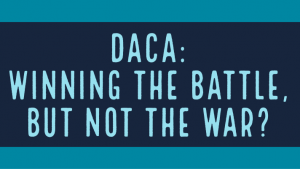
There was a national victory yesterday in the ongoing litigation involving DACA – Deferred Action for Childhood Arrivals. And while immigrants and immigration attorneys alike cheered the important U.S. Supreme Court decision, the jubilation has been tempered by the revelation of what the decision does and does not actually do for DACA eligible recipients. So, let’s take an in-depth look at the case, the issues before the Court and the Court’s holding.
What was the actual issue before the Supreme Court?
Under the Obama administration, DACA was expanded and a new form of deferred action called DAPA was announced. Many states filed for injunctions to prevent the expansion of DACA and the implementation of DAPA. When the Trump administration came to power, the Attorney General told the Acting Director of Department of Homeland Security that DAPA and DACA were illegal and therefore, she should discontinue DACA. So, DHS allowed for a renewal for those whose DACA was about to expire, but no new DACA applications would be accepted and no other DACA renewals would be accepted. Multiple petitioners filed for injunctions claiming that the decision was a violation of the Administrative Procedure Act (APA) because it was “arbitrary and capricious.” Various Circuit Courts agreed with the Petitioners and the U.S. Supreme Court agreed to hear the case.
The only issues before the Supreme Court were 1) whether the Attorney General’s decision was reviewable under the APA, 2) whether DHS’s decision to rescind DACA was arbitrary and capricious, and 3) whether the decision was a violation of the Equal Protection Clause of the Constitution.
Is the Attorney General’s decision to rescind DACA reviewable by the Court?
The Supreme Court held that the Attorney General’s decision to rescind DACA was reviewable by the Court because the memorandum creating DACA did not merely decline to enforce the immigration laws, but conferred affirmative immigration benefits on individuals like work authorization, access to medicare and other federal benefits. The Court also determined that provisions that preclude reviewability in the context of removal proceedings or “commencing proceedings, adjudicating cases, or executing removal orders did not apply. Therefore, the Court determined that it had jurisdiction to decide the case on the merits.
Was DHS’s decision to rescind DACA arbitrary and capricious?
According to the Supreme Court, DHS’s decision to rescind DACA was arbitrary and capricious and therefore in violation of the APA. The Court based its decision on initial memo submitted by then acting Director of DHS Duke. In the memo, Acting Director Duke stated that DACA was rescinded because it was unlawful. The memo lacked the proper analysis to support the decision. The Court also determined that later additional support of the memo by a subsequent Director could not be considered. The Court was bound by the analysis by Acting Director Duke at the time of the administrative action.
The Court also discussed the failure of the Duke memo to address the difference between forbearance and active benefits. Forbearance being the authority of DHS to not enforce removal. Active benefits being the authority of DHS to actively give benefits not authorized by law, like work authorization. The Court stated that the Attorney General made a legal determination that the giving of benefits was illegal, but DHS’s authority to decide not to enforce removal was unimpaired, yet this was not addressed in the Duke’s memo. Therefore, Dukes could have taken away the benefits of DACA (i.e. work authorization), but still deferred action on removal. Because the memo did not address any substantiated reason why DHS should not simply take away the benefits, but leave the non-enforcement of removal for DACA recipients, the decision was arbitrary and capricious.
Did DHS’s decision violate the Equal Protection Clause?
The Court said that DHS’s decision did not violate the Equal Protection Clause. The Court did away with this argument relatively quickly. The Court listed the requirements for a successful Equal Protection claim. The plaintiff must establish invidious discriminatory purpose was a motivating factor in the relevant decision. The Plaintiff’s argued that the DHS decision disproportionately affected Latinos from Mexico, there was an unusual history behind rescission and because of comments made by President Trump. The Court held that none of these supported an Equal Protection violation.
Was DACA saved?
Unfortunately, the answer is no. The decision makes it clear that the Attorney General has the authority to end DACA. So, DHS can simply go back and submit a policy that is not arbitrary and capricious. But, the decision did prevent DHS from terminating DACA right now and under their own terms. Therefore, it remains to be seen how the Attorney General and DHS will handle this decision, what concessions they will or won’t make, and what litigation will spring forward from this decision. The long and short of it is that DACA has lived to see another day and as long as there is breath, the fight will go on.
 Jeremy Lasnetski is a partner at the Law Offices of Lasnetski Gihon Law. The firm focuses on immigration, criminal defense and personal injury. Mr. Lasnetski focuses his practice on immigration and criminal defense and is the former Jacksonville Regional Vice Chair of the American Immigration Lawyer’s Association, Central Florida Chapter. He has represented clients in deportation proceedings, USCIS benefit cases, consular processing cases, and more. He routinely gives presentations on immigration law issues to both criminal and immigration lawyers at conferences and seminars throughout the State of Florida.
Jeremy Lasnetski is a partner at the Law Offices of Lasnetski Gihon Law. The firm focuses on immigration, criminal defense and personal injury. Mr. Lasnetski focuses his practice on immigration and criminal defense and is the former Jacksonville Regional Vice Chair of the American Immigration Lawyer’s Association, Central Florida Chapter. He has represented clients in deportation proceedings, USCIS benefit cases, consular processing cases, and more. He routinely gives presentations on immigration law issues to both criminal and immigration lawyers at conferences and seminars throughout the State of Florida.
 Florida Immigration Lawyer Blog
Florida Immigration Lawyer Blog

